Financial Analysis of Tesco
VerifiedAdded on 2023/06/10
|17
|4608
|121
AI Summary
The report evaluates the financial performance of Tesco plc. using ratio analysis and analyses the financial worthiness of one of its potential suppliers. It also examines the soundness of corporate governance structure of Tesco and its performance in terms of corporate social responsibilities.
Contribute Materials
Your contribution can guide someone’s learning journey. Share your
documents today.
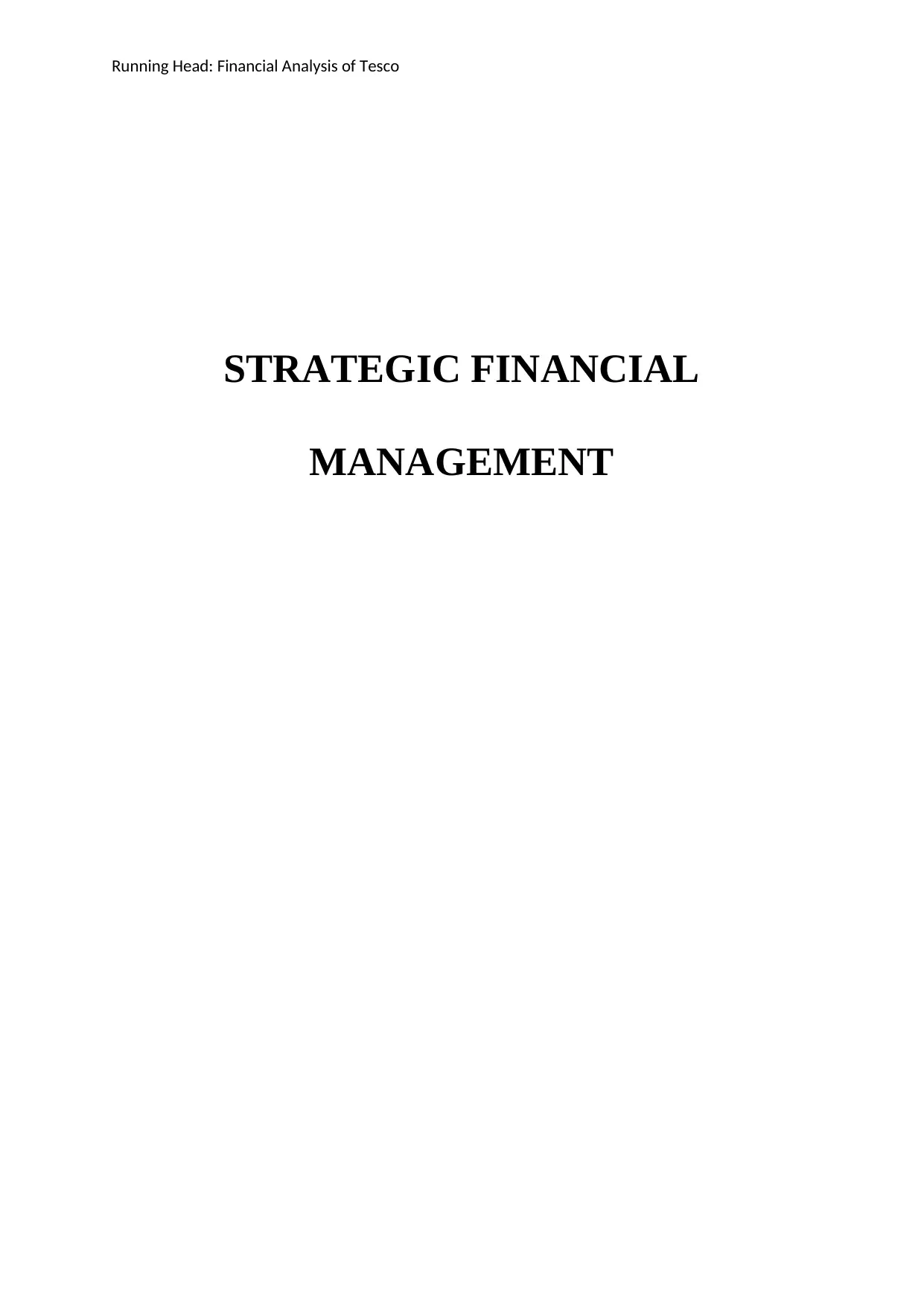
Running Head: Financial Analysis of Tesco
STRATEGIC FINANCIAL
MANAGEMENT
STRATEGIC FINANCIAL
MANAGEMENT
Secure Best Marks with AI Grader
Need help grading? Try our AI Grader for instant feedback on your assignments.
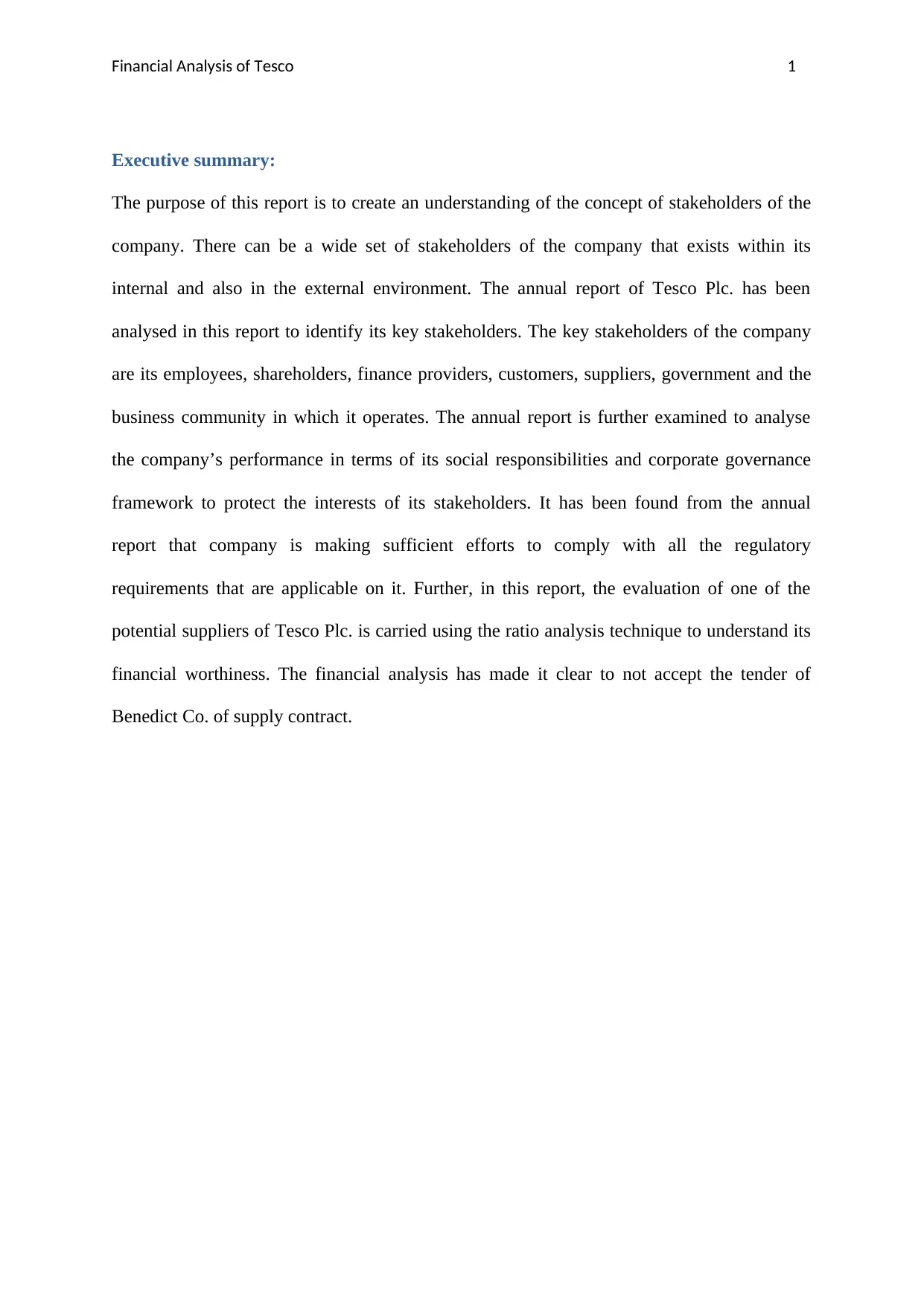
Financial Analysis of Tesco 1
Executive summary:
The purpose of this report is to create an understanding of the concept of stakeholders of the
company. There can be a wide set of stakeholders of the company that exists within its
internal and also in the external environment. The annual report of Tesco Plc. has been
analysed in this report to identify its key stakeholders. The key stakeholders of the company
are its employees, shareholders, finance providers, customers, suppliers, government and the
business community in which it operates. The annual report is further examined to analyse
the company’s performance in terms of its social responsibilities and corporate governance
framework to protect the interests of its stakeholders. It has been found from the annual
report that company is making sufficient efforts to comply with all the regulatory
requirements that are applicable on it. Further, in this report, the evaluation of one of the
potential suppliers of Tesco Plc. is carried using the ratio analysis technique to understand its
financial worthiness. The financial analysis has made it clear to not accept the tender of
Benedict Co. of supply contract.
Executive summary:
The purpose of this report is to create an understanding of the concept of stakeholders of the
company. There can be a wide set of stakeholders of the company that exists within its
internal and also in the external environment. The annual report of Tesco Plc. has been
analysed in this report to identify its key stakeholders. The key stakeholders of the company
are its employees, shareholders, finance providers, customers, suppliers, government and the
business community in which it operates. The annual report is further examined to analyse
the company’s performance in terms of its social responsibilities and corporate governance
framework to protect the interests of its stakeholders. It has been found from the annual
report that company is making sufficient efforts to comply with all the regulatory
requirements that are applicable on it. Further, in this report, the evaluation of one of the
potential suppliers of Tesco Plc. is carried using the ratio analysis technique to understand its
financial worthiness. The financial analysis has made it clear to not accept the tender of
Benedict Co. of supply contract.
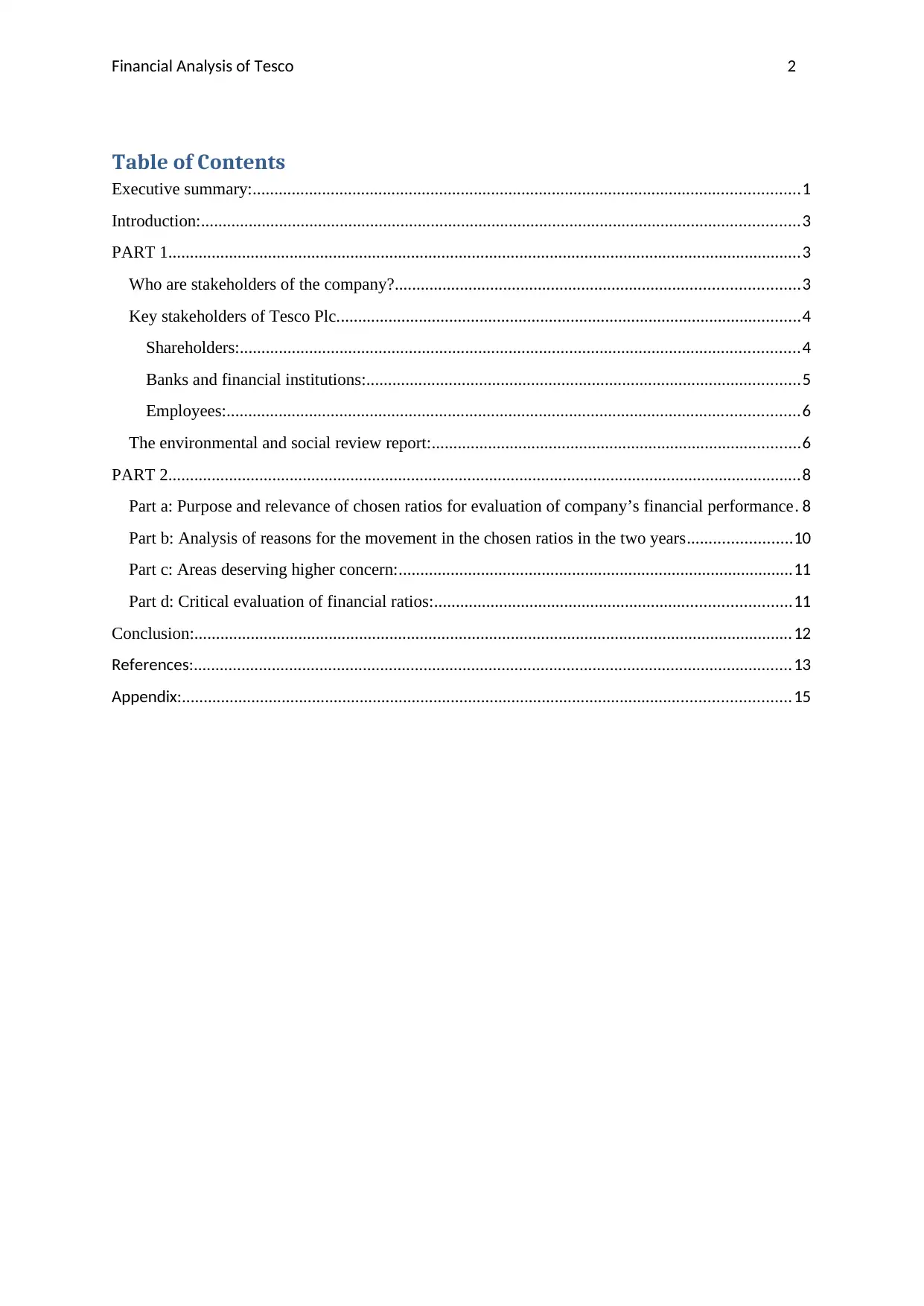
Financial Analysis of Tesco 2
Table of Contents
Executive summary:..............................................................................................................................1
Introduction:..........................................................................................................................................3
PART 1..................................................................................................................................................3
Who are stakeholders of the company?.............................................................................................3
Key stakeholders of Tesco Plc...........................................................................................................4
Shareholders:.................................................................................................................................4
Banks and financial institutions:....................................................................................................5
Employees:....................................................................................................................................6
The environmental and social review report:.....................................................................................6
PART 2..................................................................................................................................................8
Part a: Purpose and relevance of chosen ratios for evaluation of company’s financial performance. 8
Part b: Analysis of reasons for the movement in the chosen ratios in the two years........................10
Part c: Areas deserving higher concern:...........................................................................................11
Part d: Critical evaluation of financial ratios:..................................................................................11
Conclusion:..........................................................................................................................................12
References:..........................................................................................................................................13
Appendix:............................................................................................................................................15
Table of Contents
Executive summary:..............................................................................................................................1
Introduction:..........................................................................................................................................3
PART 1..................................................................................................................................................3
Who are stakeholders of the company?.............................................................................................3
Key stakeholders of Tesco Plc...........................................................................................................4
Shareholders:.................................................................................................................................4
Banks and financial institutions:....................................................................................................5
Employees:....................................................................................................................................6
The environmental and social review report:.....................................................................................6
PART 2..................................................................................................................................................8
Part a: Purpose and relevance of chosen ratios for evaluation of company’s financial performance. 8
Part b: Analysis of reasons for the movement in the chosen ratios in the two years........................10
Part c: Areas deserving higher concern:...........................................................................................11
Part d: Critical evaluation of financial ratios:..................................................................................11
Conclusion:..........................................................................................................................................12
References:..........................................................................................................................................13
Appendix:............................................................................................................................................15
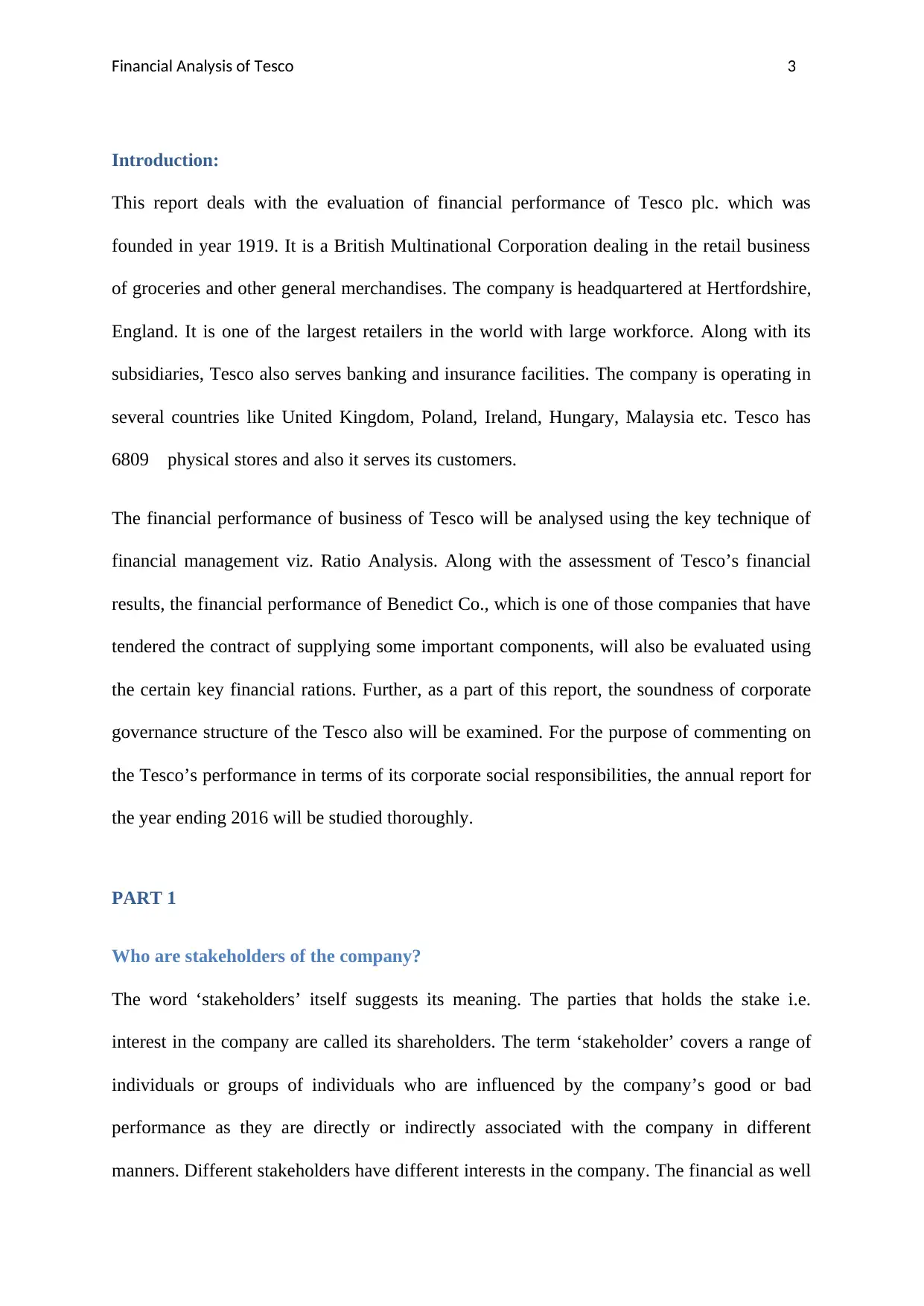
Financial Analysis of Tesco 3
Introduction:
This report deals with the evaluation of financial performance of Tesco plc. which was
founded in year 1919. It is a British Multinational Corporation dealing in the retail business
of groceries and other general merchandises. The company is headquartered at Hertfordshire,
England. It is one of the largest retailers in the world with large workforce. Along with its
subsidiaries, Tesco also serves banking and insurance facilities. The company is operating in
several countries like United Kingdom, Poland, Ireland, Hungary, Malaysia etc. Tesco has
6809 physical stores and also it serves its customers.
The financial performance of business of Tesco will be analysed using the key technique of
financial management viz. Ratio Analysis. Along with the assessment of Tesco’s financial
results, the financial performance of Benedict Co., which is one of those companies that have
tendered the contract of supplying some important components, will also be evaluated using
the certain key financial rations. Further, as a part of this report, the soundness of corporate
governance structure of the Tesco also will be examined. For the purpose of commenting on
the Tesco’s performance in terms of its corporate social responsibilities, the annual report for
the year ending 2016 will be studied thoroughly.
PART 1
Who are stakeholders of the company?
The word ‘stakeholders’ itself suggests its meaning. The parties that holds the stake i.e.
interest in the company are called its shareholders. The term ‘stakeholder’ covers a range of
individuals or groups of individuals who are influenced by the company’s good or bad
performance as they are directly or indirectly associated with the company in different
manners. Different stakeholders have different interests in the company. The financial as well
Introduction:
This report deals with the evaluation of financial performance of Tesco plc. which was
founded in year 1919. It is a British Multinational Corporation dealing in the retail business
of groceries and other general merchandises. The company is headquartered at Hertfordshire,
England. It is one of the largest retailers in the world with large workforce. Along with its
subsidiaries, Tesco also serves banking and insurance facilities. The company is operating in
several countries like United Kingdom, Poland, Ireland, Hungary, Malaysia etc. Tesco has
6809 physical stores and also it serves its customers.
The financial performance of business of Tesco will be analysed using the key technique of
financial management viz. Ratio Analysis. Along with the assessment of Tesco’s financial
results, the financial performance of Benedict Co., which is one of those companies that have
tendered the contract of supplying some important components, will also be evaluated using
the certain key financial rations. Further, as a part of this report, the soundness of corporate
governance structure of the Tesco also will be examined. For the purpose of commenting on
the Tesco’s performance in terms of its corporate social responsibilities, the annual report for
the year ending 2016 will be studied thoroughly.
PART 1
Who are stakeholders of the company?
The word ‘stakeholders’ itself suggests its meaning. The parties that holds the stake i.e.
interest in the company are called its shareholders. The term ‘stakeholder’ covers a range of
individuals or groups of individuals who are influenced by the company’s good or bad
performance as they are directly or indirectly associated with the company in different
manners. Different stakeholders have different interests in the company. The financial as well
Secure Best Marks with AI Grader
Need help grading? Try our AI Grader for instant feedback on your assignments.
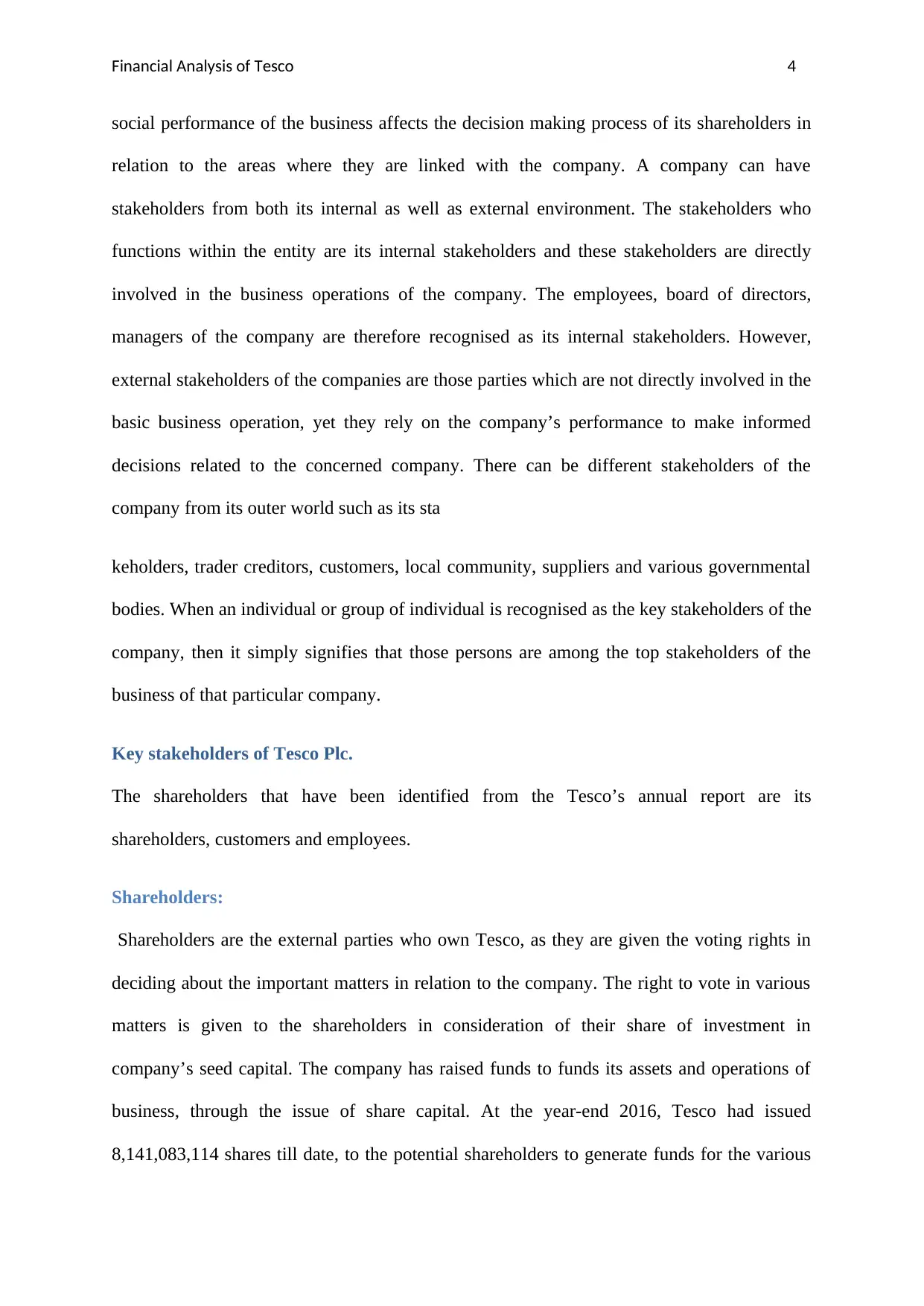
Financial Analysis of Tesco 4
social performance of the business affects the decision making process of its shareholders in
relation to the areas where they are linked with the company. A company can have
stakeholders from both its internal as well as external environment. The stakeholders who
functions within the entity are its internal stakeholders and these stakeholders are directly
involved in the business operations of the company. The employees, board of directors,
managers of the company are therefore recognised as its internal stakeholders. However,
external stakeholders of the companies are those parties which are not directly involved in the
basic business operation, yet they rely on the company’s performance to make informed
decisions related to the concerned company. There can be different stakeholders of the
company from its outer world such as its sta
keholders, trader creditors, customers, local community, suppliers and various governmental
bodies. When an individual or group of individual is recognised as the key stakeholders of the
company, then it simply signifies that those persons are among the top stakeholders of the
business of that particular company.
Key stakeholders of Tesco Plc.
The shareholders that have been identified from the Tesco’s annual report are its
shareholders, customers and employees.
Shareholders:
Shareholders are the external parties who own Tesco, as they are given the voting rights in
deciding about the important matters in relation to the company. The right to vote in various
matters is given to the shareholders in consideration of their share of investment in
company’s seed capital. The company has raised funds to funds its assets and operations of
business, through the issue of share capital. At the year-end 2016, Tesco had issued
8,141,083,114 shares till date, to the potential shareholders to generate funds for the various
social performance of the business affects the decision making process of its shareholders in
relation to the areas where they are linked with the company. A company can have
stakeholders from both its internal as well as external environment. The stakeholders who
functions within the entity are its internal stakeholders and these stakeholders are directly
involved in the business operations of the company. The employees, board of directors,
managers of the company are therefore recognised as its internal stakeholders. However,
external stakeholders of the companies are those parties which are not directly involved in the
basic business operation, yet they rely on the company’s performance to make informed
decisions related to the concerned company. There can be different stakeholders of the
company from its outer world such as its sta
keholders, trader creditors, customers, local community, suppliers and various governmental
bodies. When an individual or group of individual is recognised as the key stakeholders of the
company, then it simply signifies that those persons are among the top stakeholders of the
business of that particular company.
Key stakeholders of Tesco Plc.
The shareholders that have been identified from the Tesco’s annual report are its
shareholders, customers and employees.
Shareholders:
Shareholders are the external parties who own Tesco, as they are given the voting rights in
deciding about the important matters in relation to the company. The right to vote in various
matters is given to the shareholders in consideration of their share of investment in
company’s seed capital. The company has raised funds to funds its assets and operations of
business, through the issue of share capital. At the year-end 2016, Tesco had issued
8,141,083,114 shares till date, to the potential shareholders to generate funds for the various
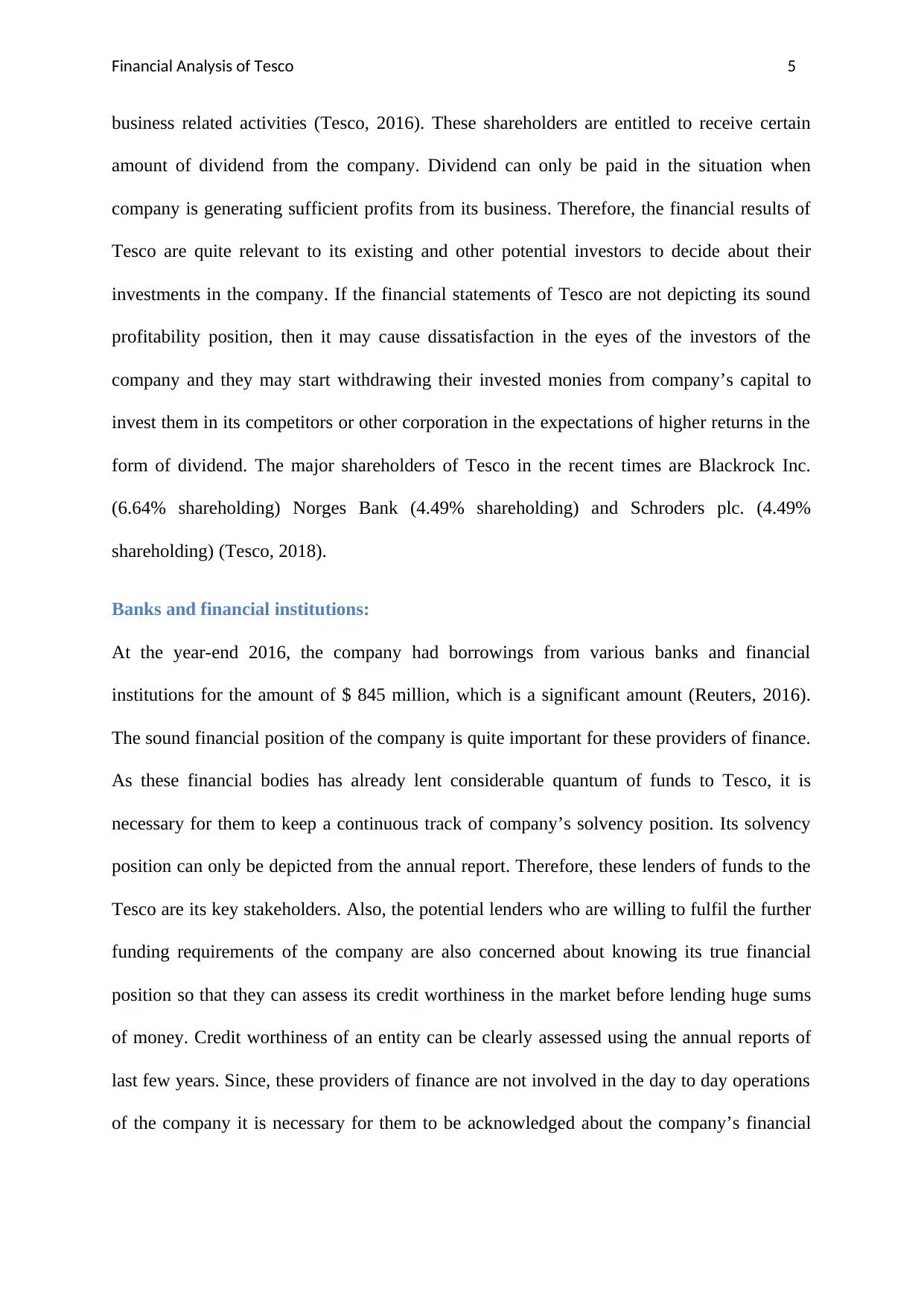
Financial Analysis of Tesco 5
business related activities (Tesco, 2016). These shareholders are entitled to receive certain
amount of dividend from the company. Dividend can only be paid in the situation when
company is generating sufficient profits from its business. Therefore, the financial results of
Tesco are quite relevant to its existing and other potential investors to decide about their
investments in the company. If the financial statements of Tesco are not depicting its sound
profitability position, then it may cause dissatisfaction in the eyes of the investors of the
company and they may start withdrawing their invested monies from company’s capital to
invest them in its competitors or other corporation in the expectations of higher returns in the
form of dividend. The major shareholders of Tesco in the recent times are Blackrock Inc.
(6.64% shareholding) Norges Bank (4.49% shareholding) and Schroders plc. (4.49%
shareholding) (Tesco, 2018).
Banks and financial institutions:
At the year-end 2016, the company had borrowings from various banks and financial
institutions for the amount of $ 845 million, which is a significant amount (Reuters, 2016).
The sound financial position of the company is quite important for these providers of finance.
As these financial bodies has already lent considerable quantum of funds to Tesco, it is
necessary for them to keep a continuous track of company’s solvency position. Its solvency
position can only be depicted from the annual report. Therefore, these lenders of funds to the
Tesco are its key stakeholders. Also, the potential lenders who are willing to fulfil the further
funding requirements of the company are also concerned about knowing its true financial
position so that they can assess its credit worthiness in the market before lending huge sums
of money. Credit worthiness of an entity can be clearly assessed using the annual reports of
last few years. Since, these providers of finance are not involved in the day to day operations
of the company it is necessary for them to be acknowledged about the company’s financial
business related activities (Tesco, 2016). These shareholders are entitled to receive certain
amount of dividend from the company. Dividend can only be paid in the situation when
company is generating sufficient profits from its business. Therefore, the financial results of
Tesco are quite relevant to its existing and other potential investors to decide about their
investments in the company. If the financial statements of Tesco are not depicting its sound
profitability position, then it may cause dissatisfaction in the eyes of the investors of the
company and they may start withdrawing their invested monies from company’s capital to
invest them in its competitors or other corporation in the expectations of higher returns in the
form of dividend. The major shareholders of Tesco in the recent times are Blackrock Inc.
(6.64% shareholding) Norges Bank (4.49% shareholding) and Schroders plc. (4.49%
shareholding) (Tesco, 2018).
Banks and financial institutions:
At the year-end 2016, the company had borrowings from various banks and financial
institutions for the amount of $ 845 million, which is a significant amount (Reuters, 2016).
The sound financial position of the company is quite important for these providers of finance.
As these financial bodies has already lent considerable quantum of funds to Tesco, it is
necessary for them to keep a continuous track of company’s solvency position. Its solvency
position can only be depicted from the annual report. Therefore, these lenders of funds to the
Tesco are its key stakeholders. Also, the potential lenders who are willing to fulfil the further
funding requirements of the company are also concerned about knowing its true financial
position so that they can assess its credit worthiness in the market before lending huge sums
of money. Credit worthiness of an entity can be clearly assessed using the annual reports of
last few years. Since, these providers of finance are not involved in the day to day operations
of the company it is necessary for them to be acknowledged about the company’s financial
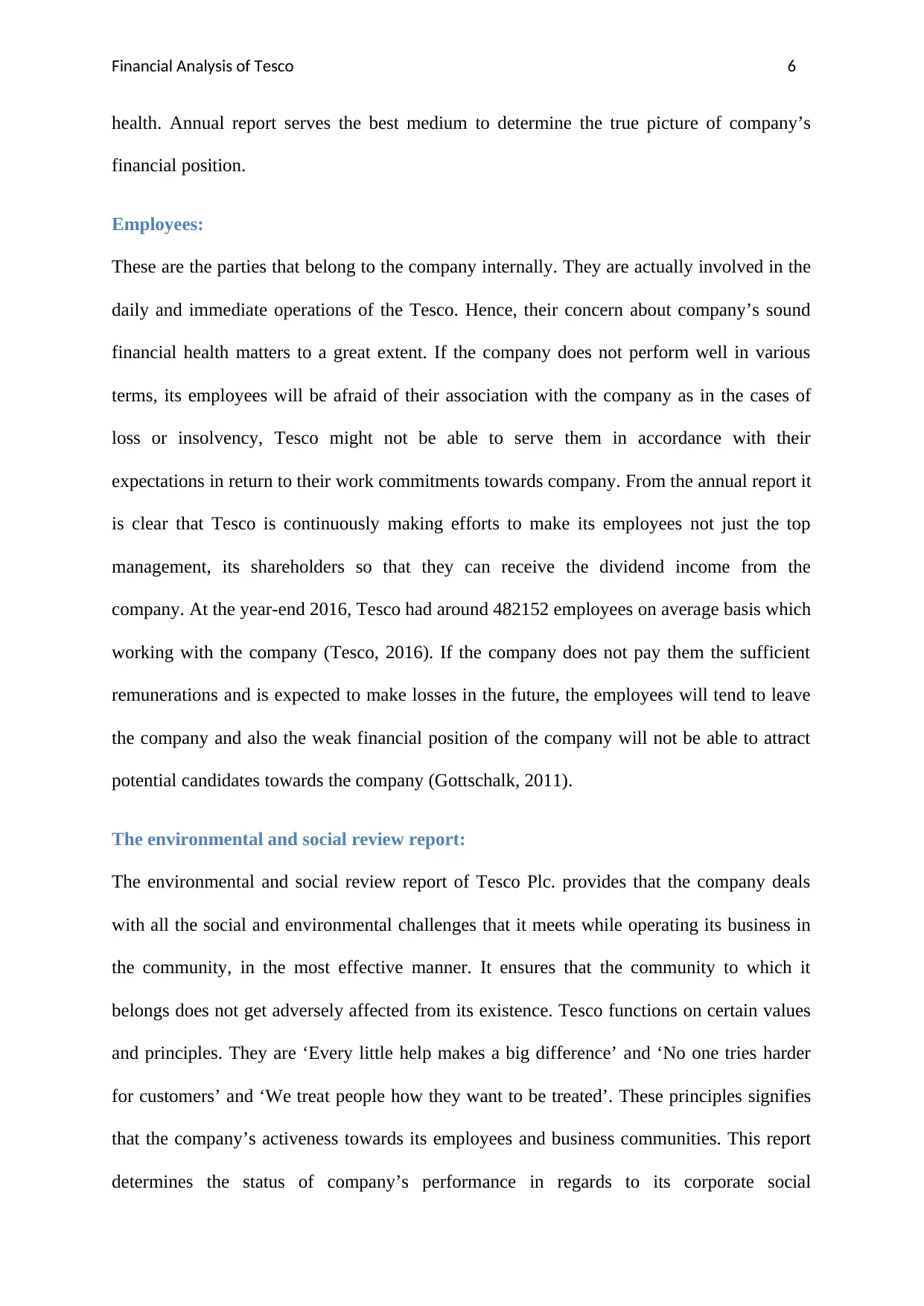
Financial Analysis of Tesco 6
health. Annual report serves the best medium to determine the true picture of company’s
financial position.
Employees:
These are the parties that belong to the company internally. They are actually involved in the
daily and immediate operations of the Tesco. Hence, their concern about company’s sound
financial health matters to a great extent. If the company does not perform well in various
terms, its employees will be afraid of their association with the company as in the cases of
loss or insolvency, Tesco might not be able to serve them in accordance with their
expectations in return to their work commitments towards company. From the annual report it
is clear that Tesco is continuously making efforts to make its employees not just the top
management, its shareholders so that they can receive the dividend income from the
company. At the year-end 2016, Tesco had around 482152 employees on average basis which
working with the company (Tesco, 2016). If the company does not pay them the sufficient
remunerations and is expected to make losses in the future, the employees will tend to leave
the company and also the weak financial position of the company will not be able to attract
potential candidates towards the company (Gottschalk, 2011).
The environmental and social review report:
The environmental and social review report of Tesco Plc. provides that the company deals
with all the social and environmental challenges that it meets while operating its business in
the community, in the most effective manner. It ensures that the community to which it
belongs does not get adversely affected from its existence. Tesco functions on certain values
and principles. They are ‘Every little help makes a big difference’ and ‘No one tries harder
for customers’ and ‘We treat people how they want to be treated’. These principles signifies
that the company’s activeness towards its employees and business communities. This report
determines the status of company’s performance in regards to its corporate social
health. Annual report serves the best medium to determine the true picture of company’s
financial position.
Employees:
These are the parties that belong to the company internally. They are actually involved in the
daily and immediate operations of the Tesco. Hence, their concern about company’s sound
financial health matters to a great extent. If the company does not perform well in various
terms, its employees will be afraid of their association with the company as in the cases of
loss or insolvency, Tesco might not be able to serve them in accordance with their
expectations in return to their work commitments towards company. From the annual report it
is clear that Tesco is continuously making efforts to make its employees not just the top
management, its shareholders so that they can receive the dividend income from the
company. At the year-end 2016, Tesco had around 482152 employees on average basis which
working with the company (Tesco, 2016). If the company does not pay them the sufficient
remunerations and is expected to make losses in the future, the employees will tend to leave
the company and also the weak financial position of the company will not be able to attract
potential candidates towards the company (Gottschalk, 2011).
The environmental and social review report:
The environmental and social review report of Tesco Plc. provides that the company deals
with all the social and environmental challenges that it meets while operating its business in
the community, in the most effective manner. It ensures that the community to which it
belongs does not get adversely affected from its existence. Tesco functions on certain values
and principles. They are ‘Every little help makes a big difference’ and ‘No one tries harder
for customers’ and ‘We treat people how they want to be treated’. These principles signifies
that the company’s activeness towards its employees and business communities. This report
determines the status of company’s performance in regards to its corporate social
Paraphrase This Document
Need a fresh take? Get an instant paraphrase of this document with our AI Paraphraser
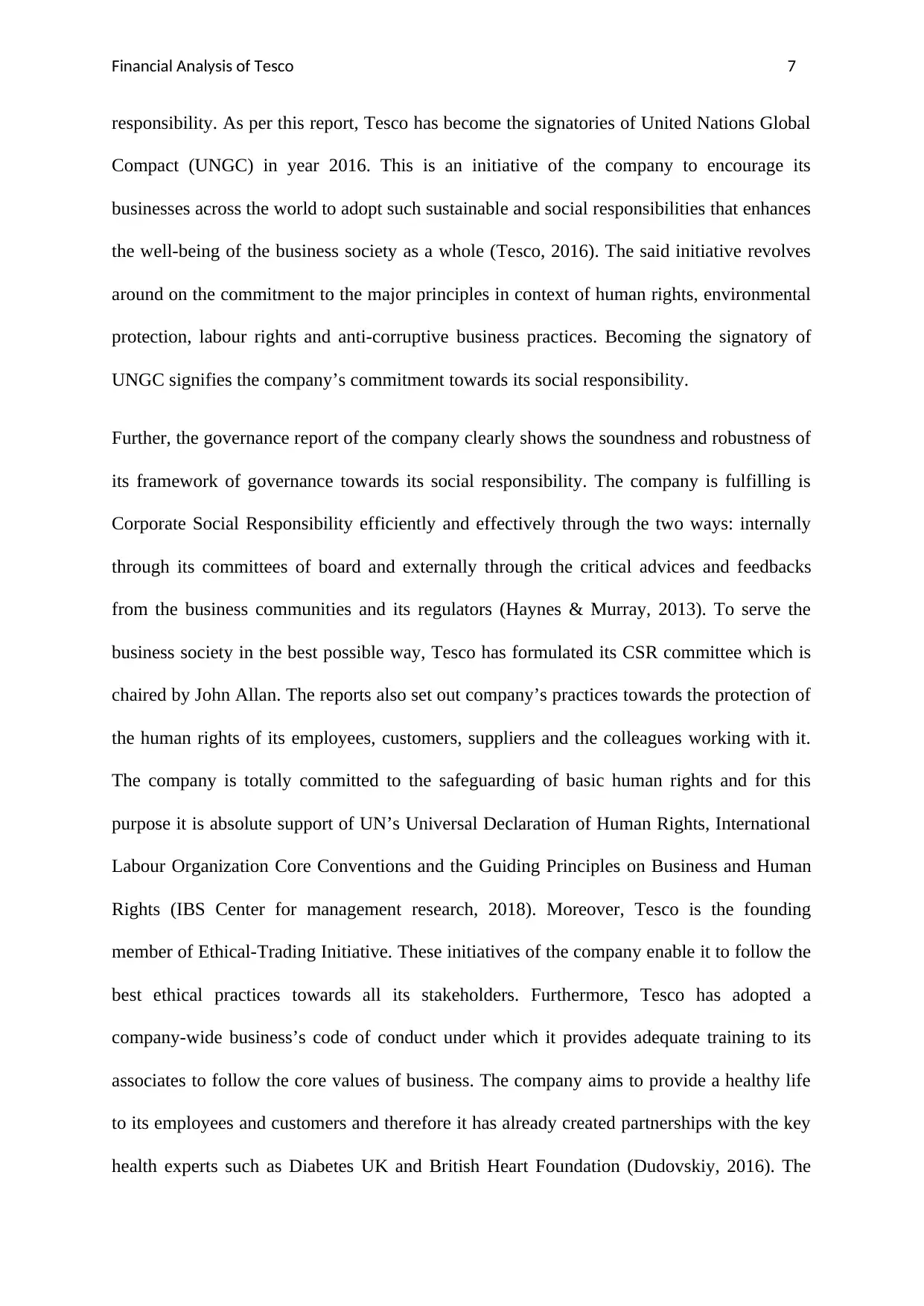
Financial Analysis of Tesco 7
responsibility. As per this report, Tesco has become the signatories of United Nations Global
Compact (UNGC) in year 2016. This is an initiative of the company to encourage its
businesses across the world to adopt such sustainable and social responsibilities that enhances
the well-being of the business society as a whole (Tesco, 2016). The said initiative revolves
around on the commitment to the major principles in context of human rights, environmental
protection, labour rights and anti-corruptive business practices. Becoming the signatory of
UNGC signifies the company’s commitment towards its social responsibility.
Further, the governance report of the company clearly shows the soundness and robustness of
its framework of governance towards its social responsibility. The company is fulfilling is
Corporate Social Responsibility efficiently and effectively through the two ways: internally
through its committees of board and externally through the critical advices and feedbacks
from the business communities and its regulators (Haynes & Murray, 2013). To serve the
business society in the best possible way, Tesco has formulated its CSR committee which is
chaired by John Allan. The reports also set out company’s practices towards the protection of
the human rights of its employees, customers, suppliers and the colleagues working with it.
The company is totally committed to the safeguarding of basic human rights and for this
purpose it is absolute support of UN’s Universal Declaration of Human Rights, International
Labour Organization Core Conventions and the Guiding Principles on Business and Human
Rights (IBS Center for management research, 2018). Moreover, Tesco is the founding
member of Ethical-Trading Initiative. These initiatives of the company enable it to follow the
best ethical practices towards all its stakeholders. Furthermore, Tesco has adopted a
company-wide business’s code of conduct under which it provides adequate training to its
associates to follow the core values of business. The company aims to provide a healthy life
to its employees and customers and therefore it has already created partnerships with the key
health experts such as Diabetes UK and British Heart Foundation (Dudovskiy, 2016). The
responsibility. As per this report, Tesco has become the signatories of United Nations Global
Compact (UNGC) in year 2016. This is an initiative of the company to encourage its
businesses across the world to adopt such sustainable and social responsibilities that enhances
the well-being of the business society as a whole (Tesco, 2016). The said initiative revolves
around on the commitment to the major principles in context of human rights, environmental
protection, labour rights and anti-corruptive business practices. Becoming the signatory of
UNGC signifies the company’s commitment towards its social responsibility.
Further, the governance report of the company clearly shows the soundness and robustness of
its framework of governance towards its social responsibility. The company is fulfilling is
Corporate Social Responsibility efficiently and effectively through the two ways: internally
through its committees of board and externally through the critical advices and feedbacks
from the business communities and its regulators (Haynes & Murray, 2013). To serve the
business society in the best possible way, Tesco has formulated its CSR committee which is
chaired by John Allan. The reports also set out company’s practices towards the protection of
the human rights of its employees, customers, suppliers and the colleagues working with it.
The company is totally committed to the safeguarding of basic human rights and for this
purpose it is absolute support of UN’s Universal Declaration of Human Rights, International
Labour Organization Core Conventions and the Guiding Principles on Business and Human
Rights (IBS Center for management research, 2018). Moreover, Tesco is the founding
member of Ethical-Trading Initiative. These initiatives of the company enable it to follow the
best ethical practices towards all its stakeholders. Furthermore, Tesco has adopted a
company-wide business’s code of conduct under which it provides adequate training to its
associates to follow the core values of business. The company aims to provide a healthy life
to its employees and customers and therefore it has already created partnerships with the key
health experts such as Diabetes UK and British Heart Foundation (Dudovskiy, 2016). The
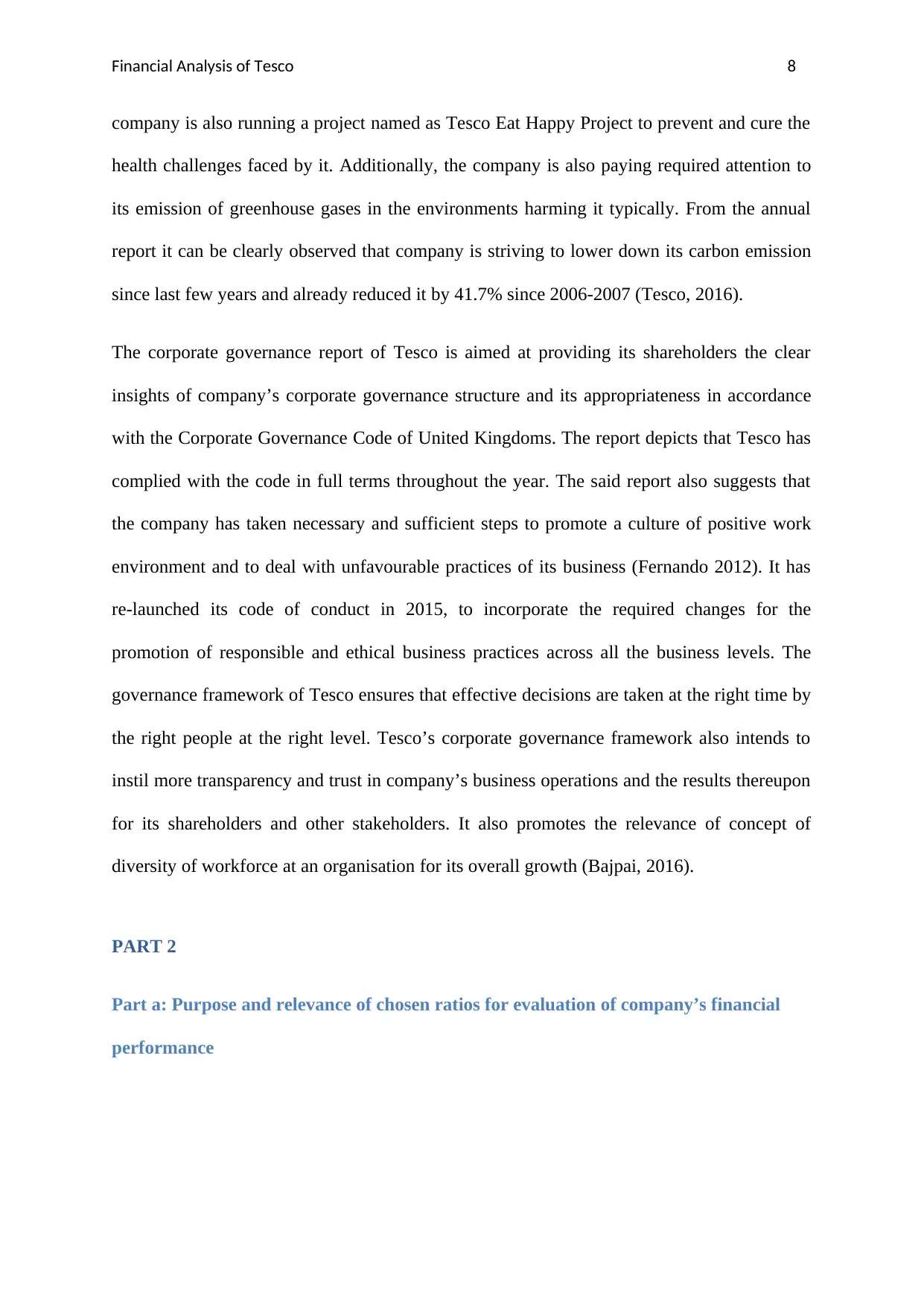
Financial Analysis of Tesco 8
company is also running a project named as Tesco Eat Happy Project to prevent and cure the
health challenges faced by it. Additionally, the company is also paying required attention to
its emission of greenhouse gases in the environments harming it typically. From the annual
report it can be clearly observed that company is striving to lower down its carbon emission
since last few years and already reduced it by 41.7% since 2006-2007 (Tesco, 2016).
The corporate governance report of Tesco is aimed at providing its shareholders the clear
insights of company’s corporate governance structure and its appropriateness in accordance
with the Corporate Governance Code of United Kingdoms. The report depicts that Tesco has
complied with the code in full terms throughout the year. The said report also suggests that
the company has taken necessary and sufficient steps to promote a culture of positive work
environment and to deal with unfavourable practices of its business (Fernando 2012). It has
re-launched its code of conduct in 2015, to incorporate the required changes for the
promotion of responsible and ethical business practices across all the business levels. The
governance framework of Tesco ensures that effective decisions are taken at the right time by
the right people at the right level. Tesco’s corporate governance framework also intends to
instil more transparency and trust in company’s business operations and the results thereupon
for its shareholders and other stakeholders. It also promotes the relevance of concept of
diversity of workforce at an organisation for its overall growth (Bajpai, 2016).
PART 2
Part a: Purpose and relevance of chosen ratios for evaluation of company’s financial
performance
company is also running a project named as Tesco Eat Happy Project to prevent and cure the
health challenges faced by it. Additionally, the company is also paying required attention to
its emission of greenhouse gases in the environments harming it typically. From the annual
report it can be clearly observed that company is striving to lower down its carbon emission
since last few years and already reduced it by 41.7% since 2006-2007 (Tesco, 2016).
The corporate governance report of Tesco is aimed at providing its shareholders the clear
insights of company’s corporate governance structure and its appropriateness in accordance
with the Corporate Governance Code of United Kingdoms. The report depicts that Tesco has
complied with the code in full terms throughout the year. The said report also suggests that
the company has taken necessary and sufficient steps to promote a culture of positive work
environment and to deal with unfavourable practices of its business (Fernando 2012). It has
re-launched its code of conduct in 2015, to incorporate the required changes for the
promotion of responsible and ethical business practices across all the business levels. The
governance framework of Tesco ensures that effective decisions are taken at the right time by
the right people at the right level. Tesco’s corporate governance framework also intends to
instil more transparency and trust in company’s business operations and the results thereupon
for its shareholders and other stakeholders. It also promotes the relevance of concept of
diversity of workforce at an organisation for its overall growth (Bajpai, 2016).
PART 2
Part a: Purpose and relevance of chosen ratios for evaluation of company’s financial
performance
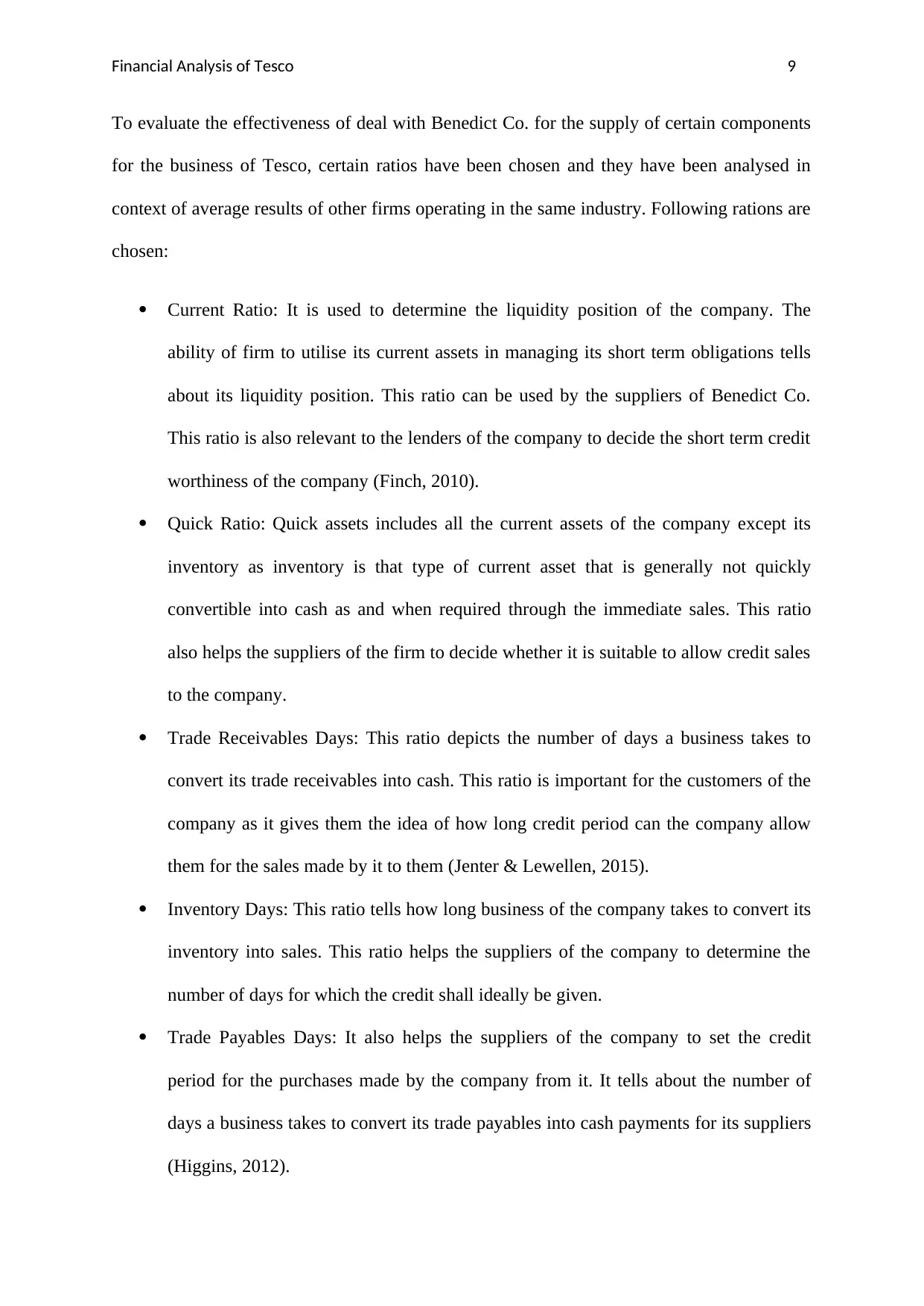
Financial Analysis of Tesco 9
To evaluate the effectiveness of deal with Benedict Co. for the supply of certain components
for the business of Tesco, certain ratios have been chosen and they have been analysed in
context of average results of other firms operating in the same industry. Following rations are
chosen:
Current Ratio: It is used to determine the liquidity position of the company. The
ability of firm to utilise its current assets in managing its short term obligations tells
about its liquidity position. This ratio can be used by the suppliers of Benedict Co.
This ratio is also relevant to the lenders of the company to decide the short term credit
worthiness of the company (Finch, 2010).
Quick Ratio: Quick assets includes all the current assets of the company except its
inventory as inventory is that type of current asset that is generally not quickly
convertible into cash as and when required through the immediate sales. This ratio
also helps the suppliers of the firm to decide whether it is suitable to allow credit sales
to the company.
Trade Receivables Days: This ratio depicts the number of days a business takes to
convert its trade receivables into cash. This ratio is important for the customers of the
company as it gives them the idea of how long credit period can the company allow
them for the sales made by it to them (Jenter & Lewellen, 2015).
Inventory Days: This ratio tells how long business of the company takes to convert its
inventory into sales. This ratio helps the suppliers of the company to determine the
number of days for which the credit shall ideally be given.
Trade Payables Days: It also helps the suppliers of the company to set the credit
period for the purchases made by the company from it. It tells about the number of
days a business takes to convert its trade payables into cash payments for its suppliers
(Higgins, 2012).
To evaluate the effectiveness of deal with Benedict Co. for the supply of certain components
for the business of Tesco, certain ratios have been chosen and they have been analysed in
context of average results of other firms operating in the same industry. Following rations are
chosen:
Current Ratio: It is used to determine the liquidity position of the company. The
ability of firm to utilise its current assets in managing its short term obligations tells
about its liquidity position. This ratio can be used by the suppliers of Benedict Co.
This ratio is also relevant to the lenders of the company to decide the short term credit
worthiness of the company (Finch, 2010).
Quick Ratio: Quick assets includes all the current assets of the company except its
inventory as inventory is that type of current asset that is generally not quickly
convertible into cash as and when required through the immediate sales. This ratio
also helps the suppliers of the firm to decide whether it is suitable to allow credit sales
to the company.
Trade Receivables Days: This ratio depicts the number of days a business takes to
convert its trade receivables into cash. This ratio is important for the customers of the
company as it gives them the idea of how long credit period can the company allow
them for the sales made by it to them (Jenter & Lewellen, 2015).
Inventory Days: This ratio tells how long business of the company takes to convert its
inventory into sales. This ratio helps the suppliers of the company to determine the
number of days for which the credit shall ideally be given.
Trade Payables Days: It also helps the suppliers of the company to set the credit
period for the purchases made by the company from it. It tells about the number of
days a business takes to convert its trade payables into cash payments for its suppliers
(Higgins, 2012).
Secure Best Marks with AI Grader
Need help grading? Try our AI Grader for instant feedback on your assignments.
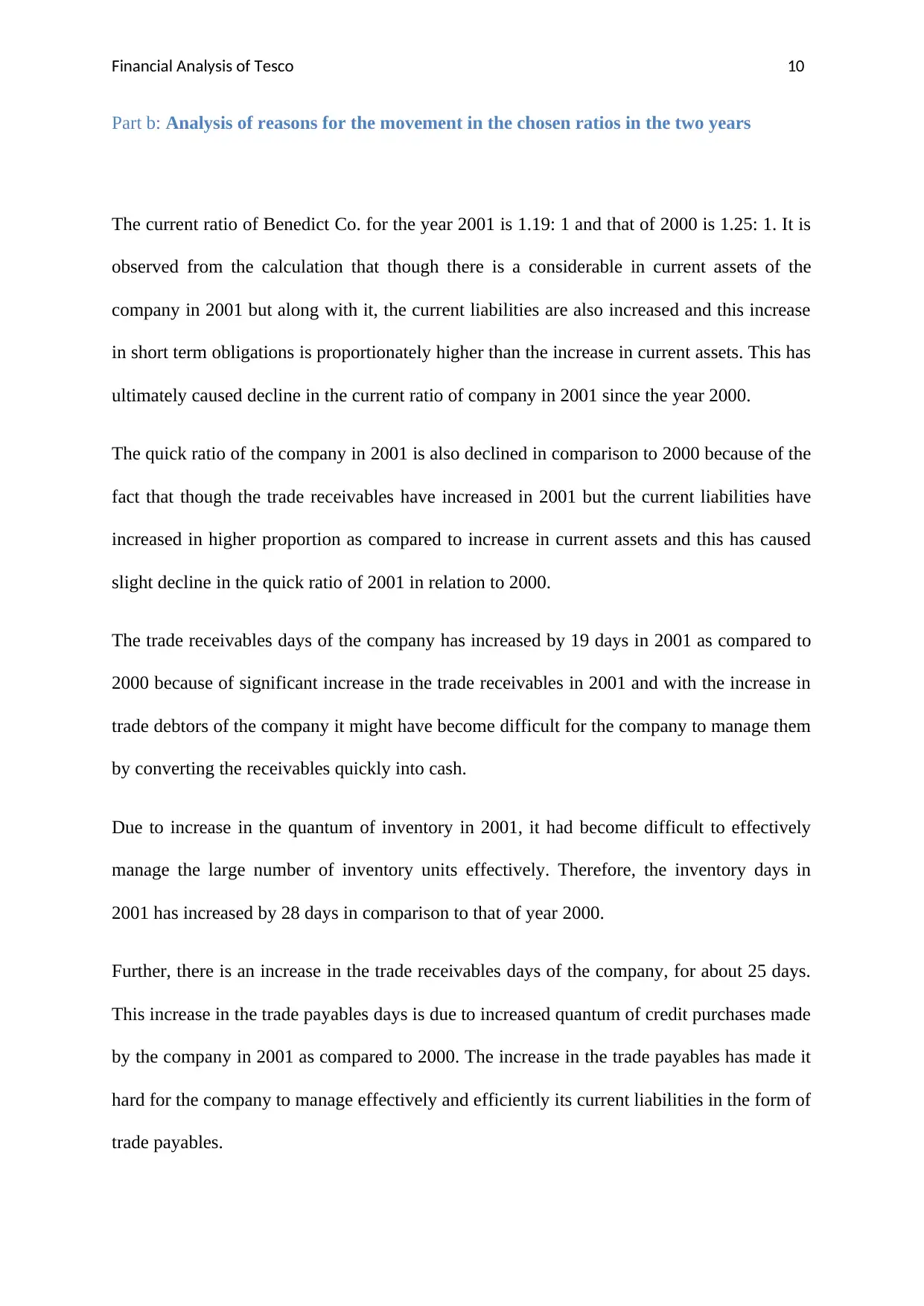
Financial Analysis of Tesco 10
Part b: Analysis of reasons for the movement in the chosen ratios in the two years
The current ratio of Benedict Co. for the year 2001 is 1.19: 1 and that of 2000 is 1.25: 1. It is
observed from the calculation that though there is a considerable in current assets of the
company in 2001 but along with it, the current liabilities are also increased and this increase
in short term obligations is proportionately higher than the increase in current assets. This has
ultimately caused decline in the current ratio of company in 2001 since the year 2000.
The quick ratio of the company in 2001 is also declined in comparison to 2000 because of the
fact that though the trade receivables have increased in 2001 but the current liabilities have
increased in higher proportion as compared to increase in current assets and this has caused
slight decline in the quick ratio of 2001 in relation to 2000.
The trade receivables days of the company has increased by 19 days in 2001 as compared to
2000 because of significant increase in the trade receivables in 2001 and with the increase in
trade debtors of the company it might have become difficult for the company to manage them
by converting the receivables quickly into cash.
Due to increase in the quantum of inventory in 2001, it had become difficult to effectively
manage the large number of inventory units effectively. Therefore, the inventory days in
2001 has increased by 28 days in comparison to that of year 2000.
Further, there is an increase in the trade receivables days of the company, for about 25 days.
This increase in the trade payables days is due to increased quantum of credit purchases made
by the company in 2001 as compared to 2000. The increase in the trade payables has made it
hard for the company to manage effectively and efficiently its current liabilities in the form of
trade payables.
Part b: Analysis of reasons for the movement in the chosen ratios in the two years
The current ratio of Benedict Co. for the year 2001 is 1.19: 1 and that of 2000 is 1.25: 1. It is
observed from the calculation that though there is a considerable in current assets of the
company in 2001 but along with it, the current liabilities are also increased and this increase
in short term obligations is proportionately higher than the increase in current assets. This has
ultimately caused decline in the current ratio of company in 2001 since the year 2000.
The quick ratio of the company in 2001 is also declined in comparison to 2000 because of the
fact that though the trade receivables have increased in 2001 but the current liabilities have
increased in higher proportion as compared to increase in current assets and this has caused
slight decline in the quick ratio of 2001 in relation to 2000.
The trade receivables days of the company has increased by 19 days in 2001 as compared to
2000 because of significant increase in the trade receivables in 2001 and with the increase in
trade debtors of the company it might have become difficult for the company to manage them
by converting the receivables quickly into cash.
Due to increase in the quantum of inventory in 2001, it had become difficult to effectively
manage the large number of inventory units effectively. Therefore, the inventory days in
2001 has increased by 28 days in comparison to that of year 2000.
Further, there is an increase in the trade receivables days of the company, for about 25 days.
This increase in the trade payables days is due to increased quantum of credit purchases made
by the company in 2001 as compared to 2000. The increase in the trade payables has made it
hard for the company to manage effectively and efficiently its current liabilities in the form of
trade payables.
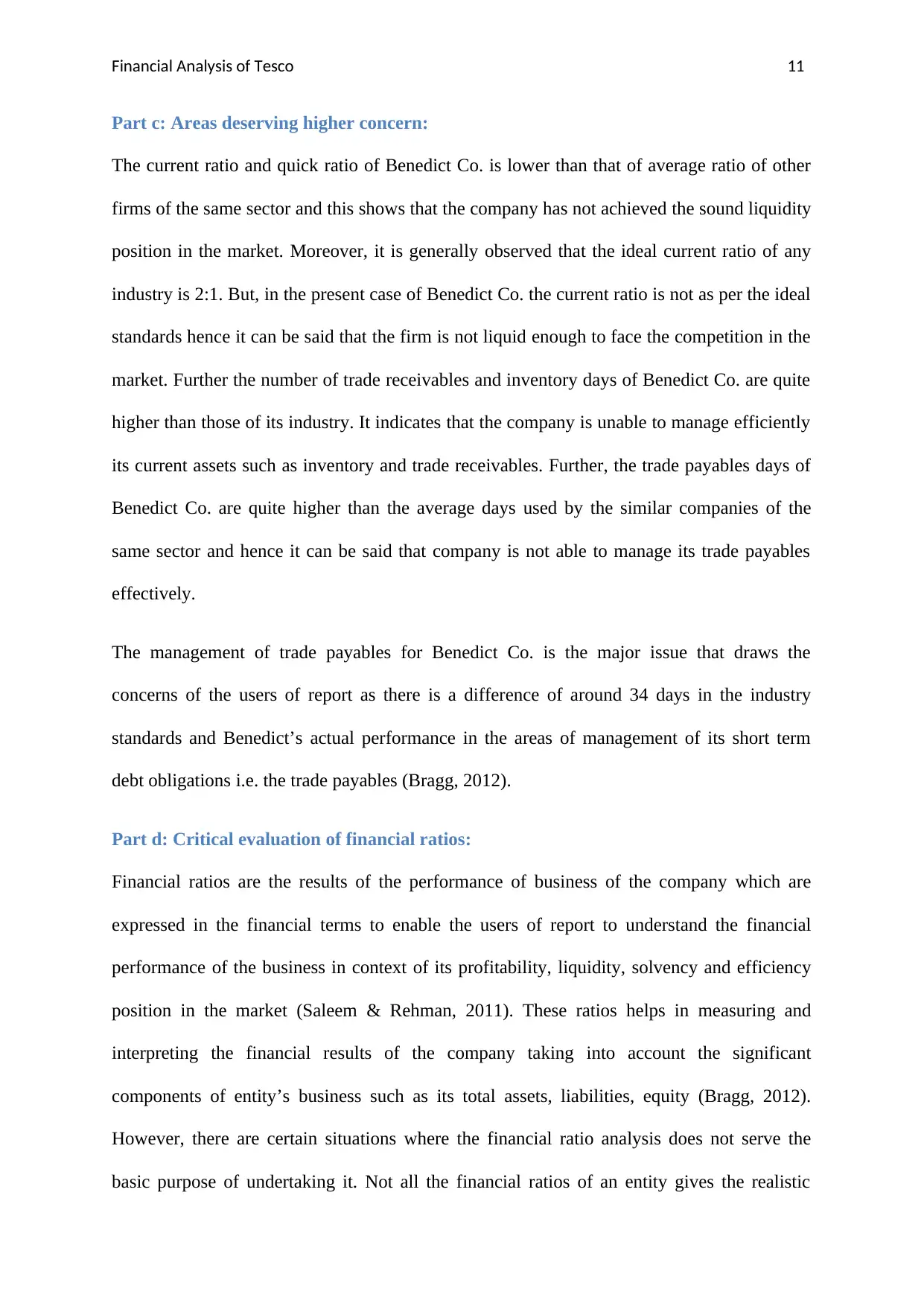
Financial Analysis of Tesco 11
Part c: Areas deserving higher concern:
The current ratio and quick ratio of Benedict Co. is lower than that of average ratio of other
firms of the same sector and this shows that the company has not achieved the sound liquidity
position in the market. Moreover, it is generally observed that the ideal current ratio of any
industry is 2:1. But, in the present case of Benedict Co. the current ratio is not as per the ideal
standards hence it can be said that the firm is not liquid enough to face the competition in the
market. Further the number of trade receivables and inventory days of Benedict Co. are quite
higher than those of its industry. It indicates that the company is unable to manage efficiently
its current assets such as inventory and trade receivables. Further, the trade payables days of
Benedict Co. are quite higher than the average days used by the similar companies of the
same sector and hence it can be said that company is not able to manage its trade payables
effectively.
The management of trade payables for Benedict Co. is the major issue that draws the
concerns of the users of report as there is a difference of around 34 days in the industry
standards and Benedict’s actual performance in the areas of management of its short term
debt obligations i.e. the trade payables (Bragg, 2012).
Part d: Critical evaluation of financial ratios:
Financial ratios are the results of the performance of business of the company which are
expressed in the financial terms to enable the users of report to understand the financial
performance of the business in context of its profitability, liquidity, solvency and efficiency
position in the market (Saleem & Rehman, 2011). These ratios helps in measuring and
interpreting the financial results of the company taking into account the significant
components of entity’s business such as its total assets, liabilities, equity (Bragg, 2012).
However, there are certain situations where the financial ratio analysis does not serve the
basic purpose of undertaking it. Not all the financial ratios of an entity gives the realistic
Part c: Areas deserving higher concern:
The current ratio and quick ratio of Benedict Co. is lower than that of average ratio of other
firms of the same sector and this shows that the company has not achieved the sound liquidity
position in the market. Moreover, it is generally observed that the ideal current ratio of any
industry is 2:1. But, in the present case of Benedict Co. the current ratio is not as per the ideal
standards hence it can be said that the firm is not liquid enough to face the competition in the
market. Further the number of trade receivables and inventory days of Benedict Co. are quite
higher than those of its industry. It indicates that the company is unable to manage efficiently
its current assets such as inventory and trade receivables. Further, the trade payables days of
Benedict Co. are quite higher than the average days used by the similar companies of the
same sector and hence it can be said that company is not able to manage its trade payables
effectively.
The management of trade payables for Benedict Co. is the major issue that draws the
concerns of the users of report as there is a difference of around 34 days in the industry
standards and Benedict’s actual performance in the areas of management of its short term
debt obligations i.e. the trade payables (Bragg, 2012).
Part d: Critical evaluation of financial ratios:
Financial ratios are the results of the performance of business of the company which are
expressed in the financial terms to enable the users of report to understand the financial
performance of the business in context of its profitability, liquidity, solvency and efficiency
position in the market (Saleem & Rehman, 2011). These ratios helps in measuring and
interpreting the financial results of the company taking into account the significant
components of entity’s business such as its total assets, liabilities, equity (Bragg, 2012).
However, there are certain situations where the financial ratio analysis does not serve the
basic purpose of undertaking it. Not all the financial ratios of an entity gives the realistic
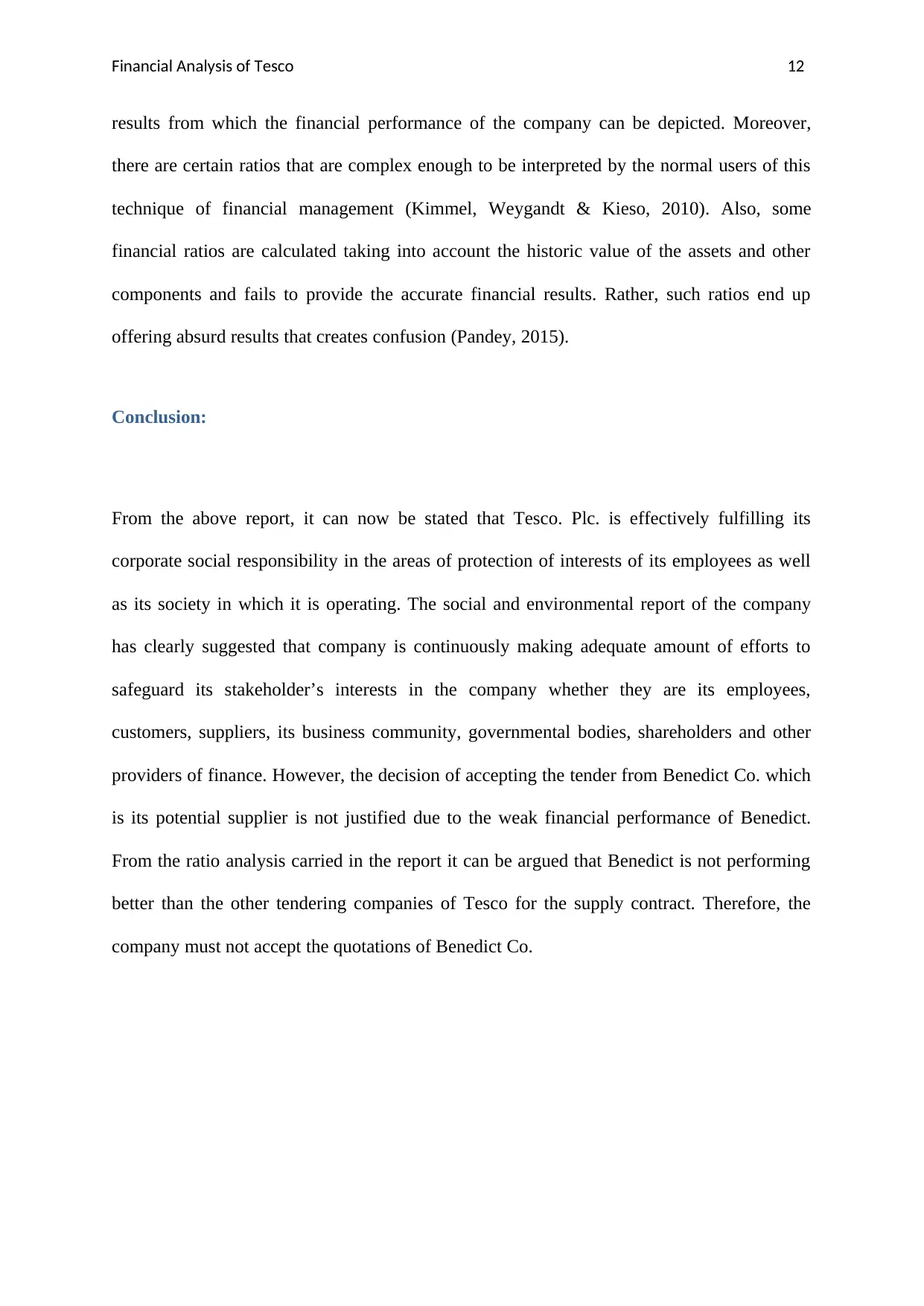
Financial Analysis of Tesco 12
results from which the financial performance of the company can be depicted. Moreover,
there are certain ratios that are complex enough to be interpreted by the normal users of this
technique of financial management (Kimmel, Weygandt & Kieso, 2010). Also, some
financial ratios are calculated taking into account the historic value of the assets and other
components and fails to provide the accurate financial results. Rather, such ratios end up
offering absurd results that creates confusion (Pandey, 2015).
Conclusion:
From the above report, it can now be stated that Tesco. Plc. is effectively fulfilling its
corporate social responsibility in the areas of protection of interests of its employees as well
as its society in which it is operating. The social and environmental report of the company
has clearly suggested that company is continuously making adequate amount of efforts to
safeguard its stakeholder’s interests in the company whether they are its employees,
customers, suppliers, its business community, governmental bodies, shareholders and other
providers of finance. However, the decision of accepting the tender from Benedict Co. which
is its potential supplier is not justified due to the weak financial performance of Benedict.
From the ratio analysis carried in the report it can be argued that Benedict is not performing
better than the other tendering companies of Tesco for the supply contract. Therefore, the
company must not accept the quotations of Benedict Co.
results from which the financial performance of the company can be depicted. Moreover,
there are certain ratios that are complex enough to be interpreted by the normal users of this
technique of financial management (Kimmel, Weygandt & Kieso, 2010). Also, some
financial ratios are calculated taking into account the historic value of the assets and other
components and fails to provide the accurate financial results. Rather, such ratios end up
offering absurd results that creates confusion (Pandey, 2015).
Conclusion:
From the above report, it can now be stated that Tesco. Plc. is effectively fulfilling its
corporate social responsibility in the areas of protection of interests of its employees as well
as its society in which it is operating. The social and environmental report of the company
has clearly suggested that company is continuously making adequate amount of efforts to
safeguard its stakeholder’s interests in the company whether they are its employees,
customers, suppliers, its business community, governmental bodies, shareholders and other
providers of finance. However, the decision of accepting the tender from Benedict Co. which
is its potential supplier is not justified due to the weak financial performance of Benedict.
From the ratio analysis carried in the report it can be argued that Benedict is not performing
better than the other tendering companies of Tesco for the supply contract. Therefore, the
company must not accept the quotations of Benedict Co.
Paraphrase This Document
Need a fresh take? Get an instant paraphrase of this document with our AI Paraphraser
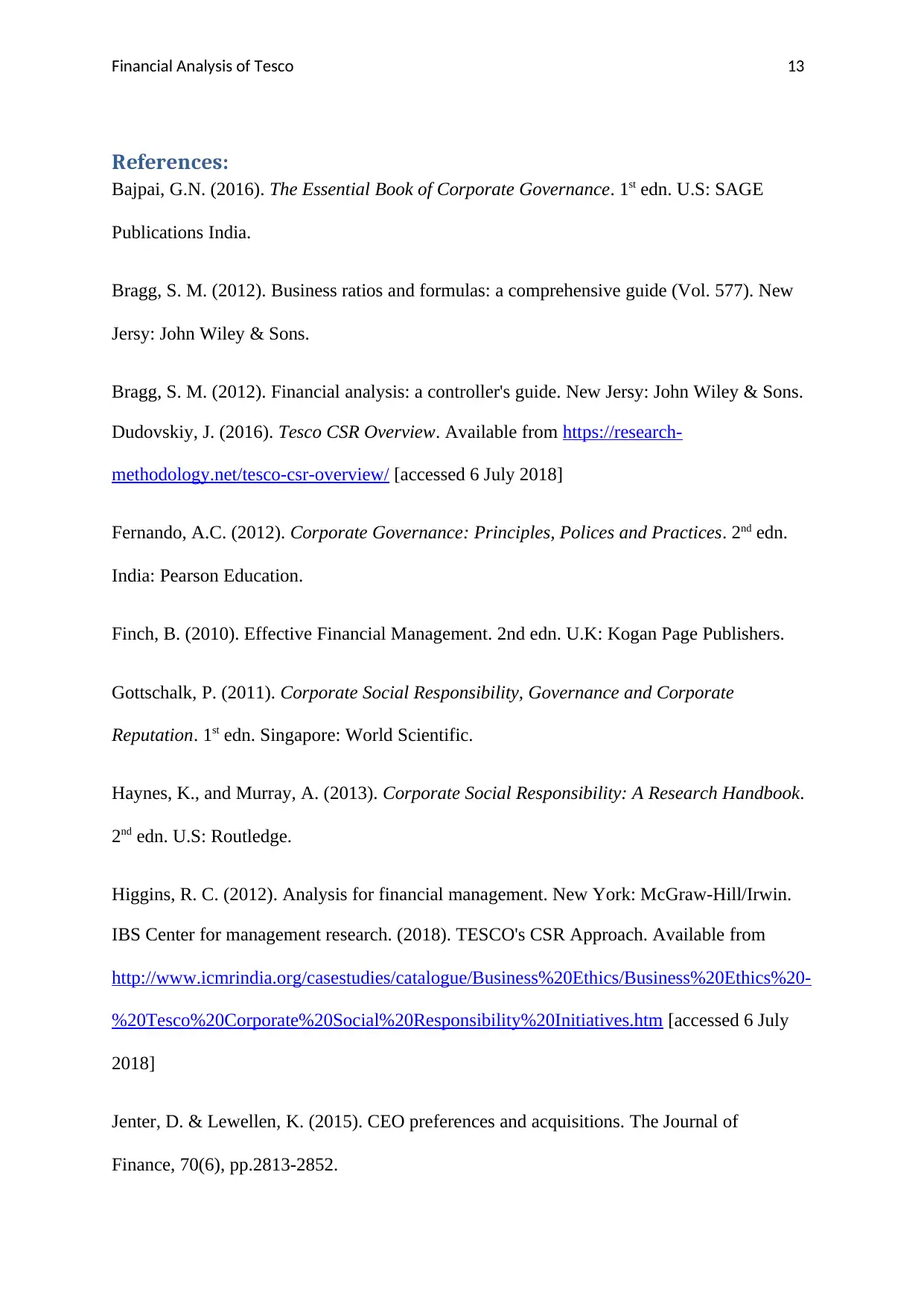
Financial Analysis of Tesco 13
References:
Bajpai, G.N. (2016). The Essential Book of Corporate Governance. 1st edn. U.S: SAGE
Publications India.
Bragg, S. M. (2012). Business ratios and formulas: a comprehensive guide (Vol. 577). New
Jersy: John Wiley & Sons.
Bragg, S. M. (2012). Financial analysis: a controller's guide. New Jersy: John Wiley & Sons.
Dudovskiy, J. (2016). Tesco CSR Overview. Available from https://research-
methodology.net/tesco-csr-overview/ [accessed 6 July 2018]
Fernando, A.C. (2012). Corporate Governance: Principles, Polices and Practices. 2nd edn.
India: Pearson Education.
Finch, B. (2010). Effective Financial Management. 2nd edn. U.K: Kogan Page Publishers.
Gottschalk, P. (2011). Corporate Social Responsibility, Governance and Corporate
Reputation. 1st edn. Singapore: World Scientific.
Haynes, K., and Murray, A. (2013). Corporate Social Responsibility: A Research Handbook.
2nd edn. U.S: Routledge.
Higgins, R. C. (2012). Analysis for financial management. New York: McGraw-Hill/Irwin.
IBS Center for management research. (2018). TESCO's CSR Approach. Available from
http://www.icmrindia.org/casestudies/catalogue/Business%20Ethics/Business%20Ethics%20-
%20Tesco%20Corporate%20Social%20Responsibility%20Initiatives.htm [accessed 6 July
2018]
Jenter, D. & Lewellen, K. (2015). CEO preferences and acquisitions. The Journal of
Finance, 70(6), pp.2813-2852.
References:
Bajpai, G.N. (2016). The Essential Book of Corporate Governance. 1st edn. U.S: SAGE
Publications India.
Bragg, S. M. (2012). Business ratios and formulas: a comprehensive guide (Vol. 577). New
Jersy: John Wiley & Sons.
Bragg, S. M. (2012). Financial analysis: a controller's guide. New Jersy: John Wiley & Sons.
Dudovskiy, J. (2016). Tesco CSR Overview. Available from https://research-
methodology.net/tesco-csr-overview/ [accessed 6 July 2018]
Fernando, A.C. (2012). Corporate Governance: Principles, Polices and Practices. 2nd edn.
India: Pearson Education.
Finch, B. (2010). Effective Financial Management. 2nd edn. U.K: Kogan Page Publishers.
Gottschalk, P. (2011). Corporate Social Responsibility, Governance and Corporate
Reputation. 1st edn. Singapore: World Scientific.
Haynes, K., and Murray, A. (2013). Corporate Social Responsibility: A Research Handbook.
2nd edn. U.S: Routledge.
Higgins, R. C. (2012). Analysis for financial management. New York: McGraw-Hill/Irwin.
IBS Center for management research. (2018). TESCO's CSR Approach. Available from
http://www.icmrindia.org/casestudies/catalogue/Business%20Ethics/Business%20Ethics%20-
%20Tesco%20Corporate%20Social%20Responsibility%20Initiatives.htm [accessed 6 July
2018]
Jenter, D. & Lewellen, K. (2015). CEO preferences and acquisitions. The Journal of
Finance, 70(6), pp.2813-2852.
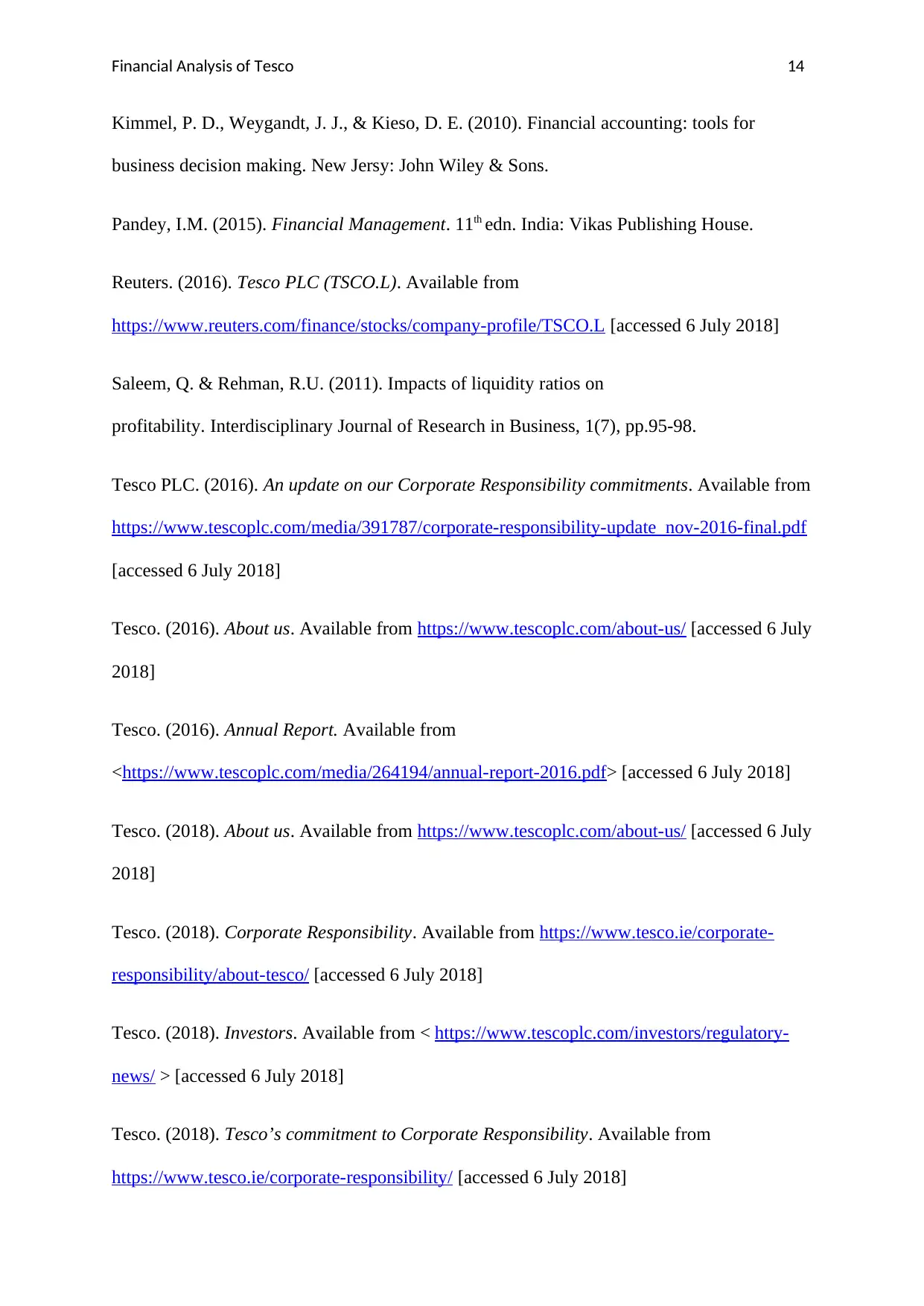
Financial Analysis of Tesco 14
Kimmel, P. D., Weygandt, J. J., & Kieso, D. E. (2010). Financial accounting: tools for
business decision making. New Jersy: John Wiley & Sons.
Pandey, I.M. (2015). Financial Management. 11th edn. India: Vikas Publishing House.
Reuters. (2016). Tesco PLC (TSCO.L). Available from
https://www.reuters.com/finance/stocks/company-profile/TSCO.L [accessed 6 July 2018]
Saleem, Q. & Rehman, R.U. (2011). Impacts of liquidity ratios on
profitability. Interdisciplinary Journal of Research in Business, 1(7), pp.95-98.
Tesco PLC. (2016). An update on our Corporate Responsibility commitments. Available from
https://www.tescoplc.com/media/391787/corporate-responsibility-update_nov-2016-final.pdf
[accessed 6 July 2018]
Tesco. (2016). About us. Available from https://www.tescoplc.com/about-us/ [accessed 6 July
2018]
Tesco. (2016). Annual Report. Available from
<https://www.tescoplc.com/media/264194/annual-report-2016.pdf> [accessed 6 July 2018]
Tesco. (2018). About us. Available from https://www.tescoplc.com/about-us/ [accessed 6 July
2018]
Tesco. (2018). Corporate Responsibility. Available from https://www.tesco.ie/corporate-
responsibility/about-tesco/ [accessed 6 July 2018]
Tesco. (2018). Investors. Available from < https://www.tescoplc.com/investors/regulatory-
news/ > [accessed 6 July 2018]
Tesco. (2018). Tesco’s commitment to Corporate Responsibility. Available from
https://www.tesco.ie/corporate-responsibility/ [accessed 6 July 2018]
Kimmel, P. D., Weygandt, J. J., & Kieso, D. E. (2010). Financial accounting: tools for
business decision making. New Jersy: John Wiley & Sons.
Pandey, I.M. (2015). Financial Management. 11th edn. India: Vikas Publishing House.
Reuters. (2016). Tesco PLC (TSCO.L). Available from
https://www.reuters.com/finance/stocks/company-profile/TSCO.L [accessed 6 July 2018]
Saleem, Q. & Rehman, R.U. (2011). Impacts of liquidity ratios on
profitability. Interdisciplinary Journal of Research in Business, 1(7), pp.95-98.
Tesco PLC. (2016). An update on our Corporate Responsibility commitments. Available from
https://www.tescoplc.com/media/391787/corporate-responsibility-update_nov-2016-final.pdf
[accessed 6 July 2018]
Tesco. (2016). About us. Available from https://www.tescoplc.com/about-us/ [accessed 6 July
2018]
Tesco. (2016). Annual Report. Available from
<https://www.tescoplc.com/media/264194/annual-report-2016.pdf> [accessed 6 July 2018]
Tesco. (2018). About us. Available from https://www.tescoplc.com/about-us/ [accessed 6 July
2018]
Tesco. (2018). Corporate Responsibility. Available from https://www.tesco.ie/corporate-
responsibility/about-tesco/ [accessed 6 July 2018]
Tesco. (2018). Investors. Available from < https://www.tescoplc.com/investors/regulatory-
news/ > [accessed 6 July 2018]
Tesco. (2018). Tesco’s commitment to Corporate Responsibility. Available from
https://www.tesco.ie/corporate-responsibility/ [accessed 6 July 2018]
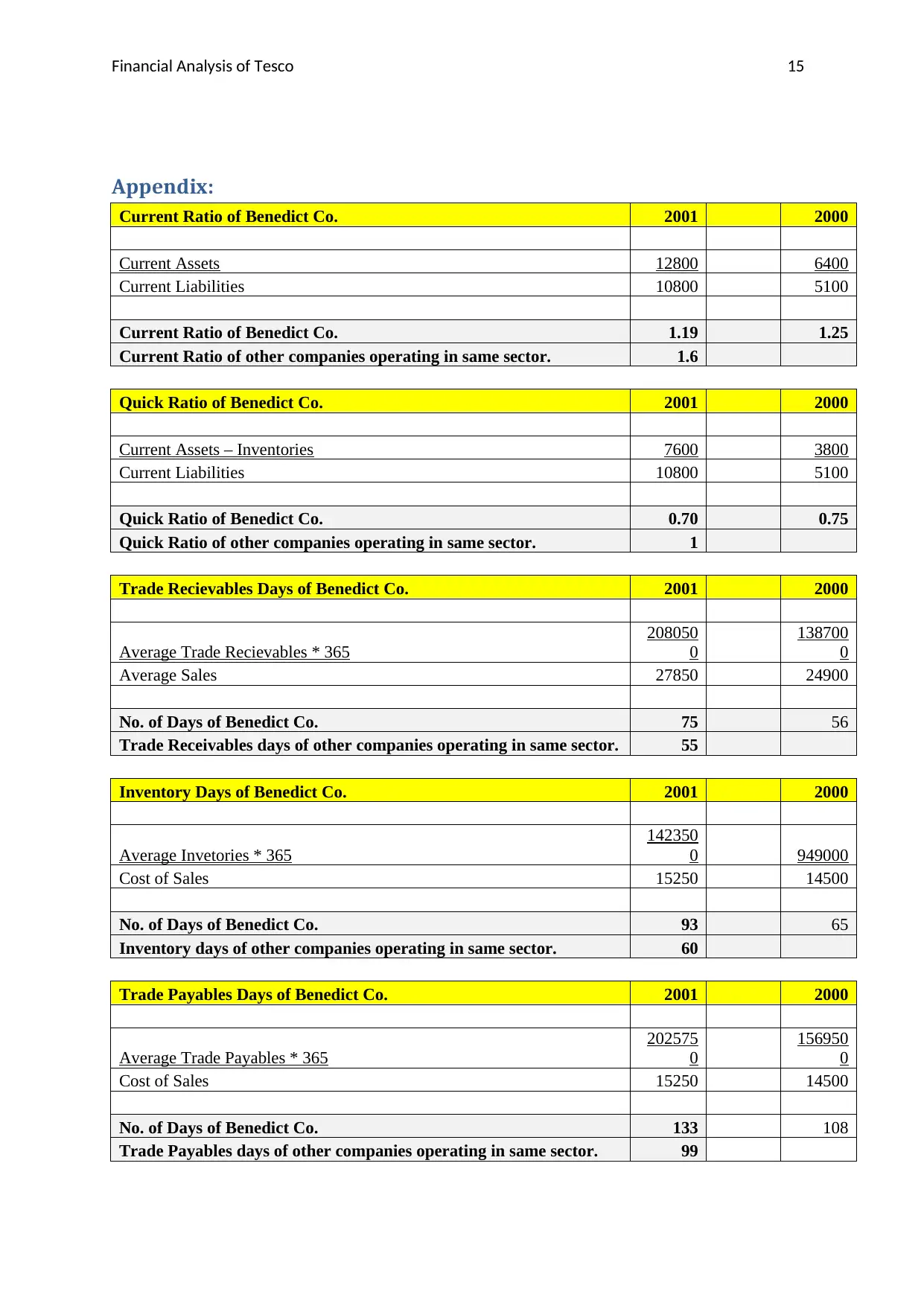
Financial Analysis of Tesco 15
Appendix:
Current Ratio of Benedict Co. 2001 2000
Current Assets 12800 6400
Current Liabilities 10800 5100
Current Ratio of Benedict Co. 1.19 1.25
Current Ratio of other companies operating in same sector. 1.6
Quick Ratio of Benedict Co. 2001 2000
Current Assets – Inventories 7600 3800
Current Liabilities 10800 5100
Quick Ratio of Benedict Co. 0.70 0.75
Quick Ratio of other companies operating in same sector. 1
Trade Recievables Days of Benedict Co. 2001 2000
Average Trade Recievables * 365
208050
0
138700
0
Average Sales 27850 24900
No. of Days of Benedict Co. 75 56
Trade Receivables days of other companies operating in same sector. 55
Inventory Days of Benedict Co. 2001 2000
Average Invetories * 365
142350
0 949000
Cost of Sales 15250 14500
No. of Days of Benedict Co. 93 65
Inventory days of other companies operating in same sector. 60
Trade Payables Days of Benedict Co. 2001 2000
Average Trade Payables * 365
202575
0
156950
0
Cost of Sales 15250 14500
No. of Days of Benedict Co. 133 108
Trade Payables days of other companies operating in same sector. 99
Appendix:
Current Ratio of Benedict Co. 2001 2000
Current Assets 12800 6400
Current Liabilities 10800 5100
Current Ratio of Benedict Co. 1.19 1.25
Current Ratio of other companies operating in same sector. 1.6
Quick Ratio of Benedict Co. 2001 2000
Current Assets – Inventories 7600 3800
Current Liabilities 10800 5100
Quick Ratio of Benedict Co. 0.70 0.75
Quick Ratio of other companies operating in same sector. 1
Trade Recievables Days of Benedict Co. 2001 2000
Average Trade Recievables * 365
208050
0
138700
0
Average Sales 27850 24900
No. of Days of Benedict Co. 75 56
Trade Receivables days of other companies operating in same sector. 55
Inventory Days of Benedict Co. 2001 2000
Average Invetories * 365
142350
0 949000
Cost of Sales 15250 14500
No. of Days of Benedict Co. 93 65
Inventory days of other companies operating in same sector. 60
Trade Payables Days of Benedict Co. 2001 2000
Average Trade Payables * 365
202575
0
156950
0
Cost of Sales 15250 14500
No. of Days of Benedict Co. 133 108
Trade Payables days of other companies operating in same sector. 99
Secure Best Marks with AI Grader
Need help grading? Try our AI Grader for instant feedback on your assignments.
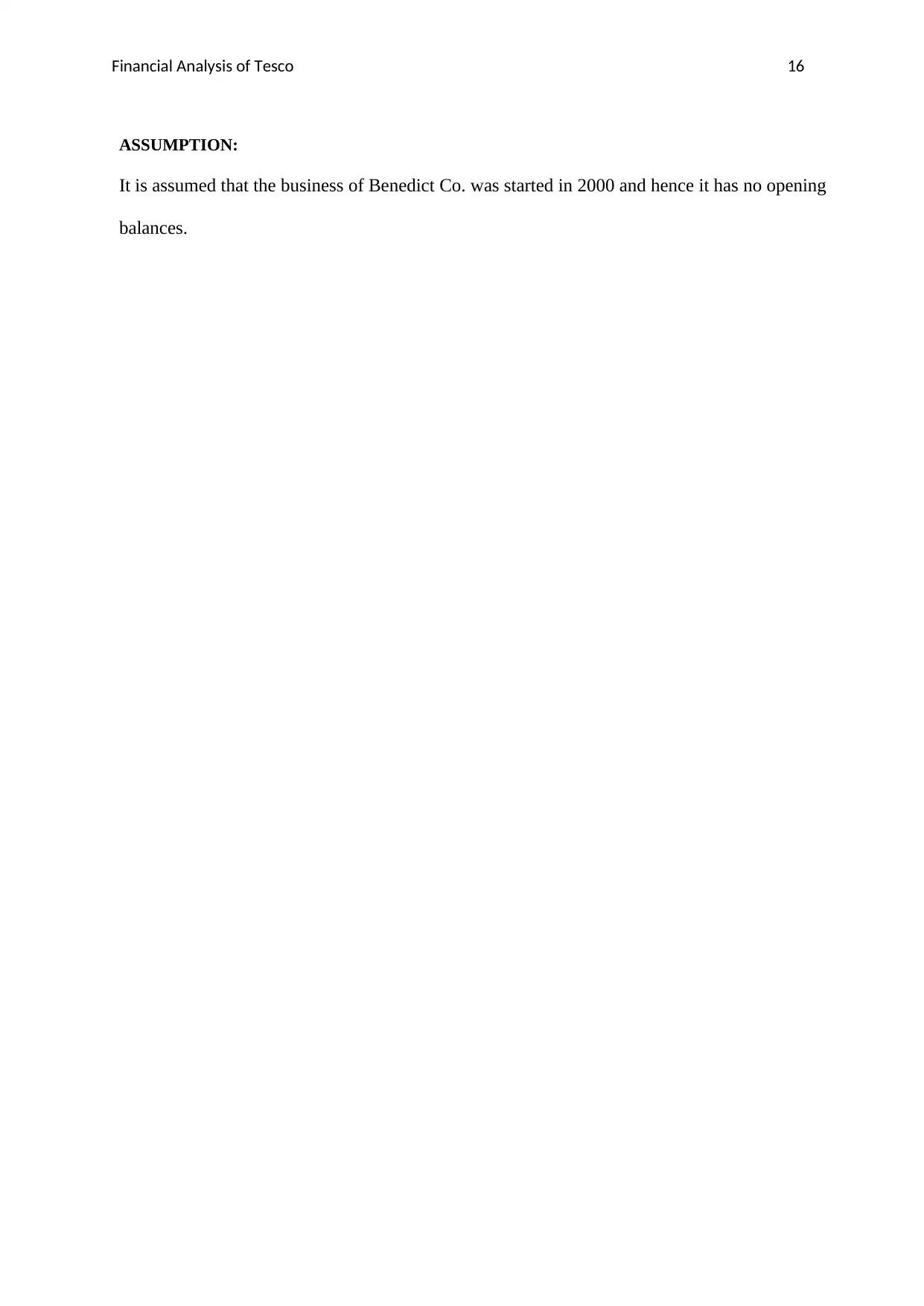
Financial Analysis of Tesco 16
ASSUMPTION:
It is assumed that the business of Benedict Co. was started in 2000 and hence it has no opening
balances.
ASSUMPTION:
It is assumed that the business of Benedict Co. was started in 2000 and hence it has no opening
balances.
1 out of 17
Related Documents
Your All-in-One AI-Powered Toolkit for Academic Success.
+13062052269
info@desklib.com
Available 24*7 on WhatsApp / Email
![[object Object]](/_next/static/media/star-bottom.7253800d.svg)
Unlock your academic potential
© 2024 | Zucol Services PVT LTD | All rights reserved.




